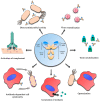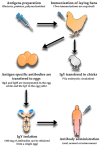Antibody-Based Immunotherapies as a Tool for Tackling Multidrug-Resistant Bacterial Infections
- PMID: 36366297
- PMCID: PMC9695245
- DOI: 10.3390/vaccines10111789
Antibody-Based Immunotherapies as a Tool for Tackling Multidrug-Resistant Bacterial Infections
Abstract
The discovery of antimicrobials is an outstanding achievement of mankind that led to the development of modern medicine. However, increasing antimicrobial resistance observed worldwide is rendering commercially available antimicrobials ineffective. This problem results from the bacterial ability to adapt to selective pressure, leading to the development or acquisition of multiple types of resistance mechanisms that can severely affect the efficacy of antimicrobials. The misuse, over-prescription, and poor treatment adherence by patients are factors strongly aggravating this issue, with an epidemic of infections untreatable by first-line therapies occurring over decades. Alternatives are required to tackle this problem, and immunotherapies are emerging as pathogen-specific and nonresistance-generating alternatives to antimicrobials. In this work, four types of antibody formats and their potential for the development of antibody-based immunotherapies against bacteria are discussed. These antibody isotypes include conventional mammalian polyclonal antibodies that are used for the neutralization of toxins; conventional mammalian monoclonal antibodies that currently have 100 IgG mAbs approved for therapeutic use; immunoglobulin Y found in birds and an excellent source of high-quality polyclonal antibodies able to be purified noninvasively from egg yolks; and single domain antibodies (also known as nanobodies), a recently discovered antibody format (found in camelids and nurse sharks) that allows for a low-cost synthesis in microbial systems, access to hidden or hard-to-reach epitopes, and exhibits a high modularity for the development of complex structures.
Keywords: antibody-based immunotherapies; immunoglobulin Y (IgY); monoclonal antibodies (mAbs); multidrug-resistant (MDR) bacterial infections; nanobodies; polyclonal antibodies (pAbs).
Conflict of interest statement
The authors declare no conflict of interest. The funders had no role in the design of the study; in the collection, analyses, or interpretation of data; in the writing of the manuscript; nor in the decision to publish the results.
Figures




References
-
- Antonelli G., Cappelli L., Cinelli P., Cuffaro R., Manca B., Nicchi S., Tondi S., Vezzani G., Viviani V., Delany I., et al. Strategies to tackle antimicrobial resistance: The example of Escherichia coli and Pseudomonas aeruginosa. Int. J. Mol. Sci. 2021;22:4943. doi: 10.3390/ijms22094943. - DOI - PMC - PubMed
-
- European Centre for Disease Prevention and Control . Antimicrobial Resistance in the EU/EEA (EARS-Net) Annual Epidemiological Report 2019. ECDC; Stockholm, Sweden: 2020.
Publication types
LinkOut - more resources
Full Text Sources

